2014新版PEP小学英语四年级下册第六单元教案
PEP小学英语四年级下册第六单元 Unit 6 At a farm教案
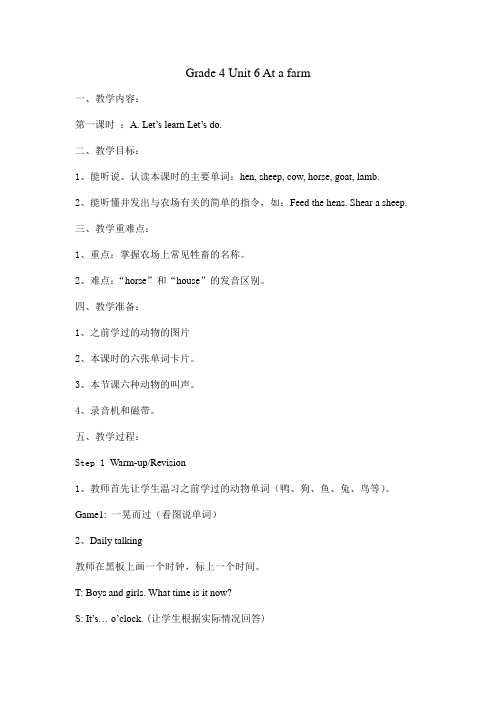
Grade 4 Unit 6 At a farm一、教学内容:第一课时:A. Let’s learn L et’s do.二、教学目标:1、能听说、认读本课时的主要单词:hen, sheep, cow, horse, goat, lamb.2、能听懂并发出与农场有关的简单的指令,如:Feed the hens. Shear a sheep.三、教学重难点:1、重点:掌握农场上常见牲畜的名称。
2、难点:“horse”和“house”的发音区别。
四、教学准备:1、之前学过的动物的图片2、本课时的六张单词卡片。
3、本节课六种动物的叫声。
4、录音机和磁带。
五、教学过程:Step 1 Warm-up/Revision1、教师首先让学生温习之前学过的动物单词(鸭、狗、鱼、兔、鸟等)。
Game1: 一晃而过(看图说单词)2、Daily talking教师在黑板上画一个时钟,标上一个时间。
T: Boys and girls. What time is it now?S: It’s… o’clock. (让学生根据实际情况回答)T: What’s the weather like today?T: Let’s go to the farm. OK?S: Ok.Step 2 PresentationEveryone! We are at the farm now, what can you see here?1、教授hena.教师播放hen的声音。
教师提问Listen! What are they?引导学生说出They are hens.b.教师出示hen的图片,教读hen的单复数读音(hen, hen, they are hens.),教师出示单词卡,标注单词的复数形式,学生跟读单词。
c. PracticeT: What colour are the hens?S: They are orange.T: How many hens can you see on the farm?S: I can see…T: Look at the hens, they are hungry. Let’s feed the hens.结合Let’s do 教学,教师示范hen, hen, feed the hens. 一边说一边做动作,学生模仿动作。
pep四年级英语下册第六单元教案

pep四年级英语下册第六单元教案第六单元第一课时教案课题:Unit6Atafarm教学重点:单词:sheep,hen,cow,horse,goat,lamb 及其复数形式的表达。
句型:whatarethey?和Arethey…?的问答。
教学难点:horse,sheep,goat的复数形式表达。
教学准备:Let’slearn(A)部分挂图,录音及。
教师和学生共同准备所学动物单词卡。
(单、复数各一套)Let’sdo部分,录音。
教学过程:(一)导入:1、教师提问:Iloveanimalsverymuch.Doyouloveanimals?whatanimalsdoyouknow?2、学生说说自己知道的动物单词,一旦学生说出本课涉及到的单词,教师要及时拿出卡片,请这位同学来教大家读。
(二)呈现新知:教师说:Doyouknowafarm?Therearemanyanimalsatafarm.Let’sgoandhavealook教师出示Let’slearn(A)部分挂图,说:Look,itisafarm.Somanyanimals.whatcanyousee?学生听懂后,教师可先试着让学生指图回答,能说出英文的学生给与表扬,也可让学生用中文回答。
告诉学生我们要学习有关farm的内容,教读farm。
让学生观看2遍,教师只点击有关单词部分,学生跟读。
教师出示单词卡:sheep,hen,cow,horse,goat,lamb,让学生进行认读,教师可以将一些发音规律,帮助学生记忆单词。
如:ee在sheep中发[i:]ow在cow中发[aU],oa在goat中发[EU]等等,也可以启发学生说说怎样记住每个单词。
(将卡片贴到黑板上)巩固单词:a、教师说单词,学生指图。
b、教师指图,学生说单词。
c、一个学生说任意一个单词,其他学生举起相应的图片。
Let’sdo部分:学生观看。
启发学生根据所看内容说说feed,ride,milk,shear,hold的意思。
PEP小学英语四年级下册第六单元教材解读(教案设计)

Unit 6 Shopping A Let’s talk 教材解读教学目标:1、能够在图片和教师的帮助下理解对话大意,并回答读后问题。
2、能够按照正确的读音、语调及意群朗读对话,并能进行角色表演。
3、能够在情境中运用句型Can I help you? Can I try ...on? Size... please。
4、能够在情景中运用句型These ... are nice. They’re too... 描述某物品。
5、能够在语境中理解try on, size, of course, too, just right的意思,并能正确发音。
教学重点:1、学会运用句型: Can I help you? 以及回答方式。
2、在商店中购物时,能够根据具体的情景进行自主的问答教学难点:能够在语境中理解try on, size, of course, too, just的意思,并能正确发音。
教学方法指导:一、导入:1、话题交流,导入新课教师出示图片,T: Look,this is a shop. These are many shoes. I like the black shoes. What about you?S: I like the ______ shoes.T: Yes, these shoes are nice.2、利用衣服图片,突破单词:try on, size, of course, too, just right3、Show the main scene and ask some questions (利用对话教材板块插图,介绍对话背景,教师提问引导学生预测对话文本内容):T:Look at the picture. Who can you see ? Where are they? What do they want to buy?二、对话文本处理:1、Let Ss watch the cartoon and answer the question:Today Mum wants to buy shoes for John. How big are his feet?2、Read and answer the question:1).The shoes of size six are __________. A. too big B. too small2).The shoes of size seven are_________. A. too big B. just right2、Tips for pronunciation:3、Listen and imitate.4、Role play三、学生活动设计:活动1、(复习说)Talk about the clothes.T:What colour are the shoes?S: They’re white. What size?T: Size 7.S: They’re nice.T: Thank you.活动2、(新授说)情境: Suppose I have a clothes shop for girls/boys. Guess what’s in my shop语言支架:Can I help you?Can I try this/these/it/them on?It’s\They’re----- .备注:配pants hat dress skirt coat sweat sock shorts …图片提供形容词small big just right …活动2、(拓展听) Listen a song about clothes and answer: What clothes did you hear?活动3、(拓展读)语言材料:Read and tick and cross. (阅读短文,判断对错,打√或×号。
PEP小学英语四年级下册第六单元教学设计

Step2 Presentation
T:boys and girls, do you know a farm?Now,look,there are many animals . (播放卡通动画片)
2、能够跟录音机读生词。
3、能够说唱B部分的歌谣。
重
点
单词:tomato、cucumber、potato、onion、carrot
①hen
T:What can you see ?(学生可用汉语回答)
S1:母鸡
T:Yes,we can see a hen.(课件出示一只母鸡的图片)Read after me
Ss: (Read it together, one by one)
T:(点击课件,出现了一群母鸡)Oh,what are they?
2、能力目标:
(1)能听懂Let’s do中的指令并做出相应动作.,如Shear a sheep。
(2)能灵活运用所学知识进行交流。
3、情感目标
(1)培养学生注意观察、认真模仿的良好习惯和主动竞争的竟识。
(2)激发学生学习英语的兴趣,使学生树立学习英语的自信心。
(3)培养学生的合作交流能力,教育学生要爱护动物。
4>Ss and Ss practise the dialogue . Are they …? Yes ,they are. / No ,they aren’t.
5>They are hens ,sheep , goats , and horses at this farm . So this farm is so big .
《掌握PEP四年级英语下册第六单元教案,轻松备课》

PEP四年级英语下册第六单元是非常重要的一节课,对于四年级英语学生来说,这是一个很好的机会,能够掌握更多的英语知识和技能。
但是为了教好这节课,老师需要准备一份完整的教案,来确保学生们能够夯实自己的英语基础。
如果您正在准备教案,本文将会帮助您轻松应对。
第一步:准备教学资料在准备教案之前,老师需要做好教学资料的准备工作。
老师需要阅读PEP四年级英语下册第六单元的教材,了解教材中的主要内容和重点知识。
老师可以收集相关练习题、课件、PPT或者其他教学资料,帮助学生更好地掌握课程内容。
老师还需要准备相关教具,如图示、触手可及的实物或者PPT等辅助教学的内容。
第二步:分析教材在准备教案时,需要仔细地分析教材,挖掘出其中的核心素材。
观察教材中涉及到的句型、单词及语音、语法等各个方面的内容,以便更好地组织布置教学内容。
同时,老师还应该注意课堂时间、教材难度、学生基础素质等因素。
在分析教材时,应尽量以学生实际的情况为发展方向。
第三步:确定教学目标教学目标是指要达到什么程度和效果。
在确定教学目标的时候,老师应该结合教材难度和学生基础素质,确定适当的目标。
在确定教学目标时,必须考虑到要达到的目标、学生是否能够达到目标以及需要哪些教学策略等事项。
第四步:教学重点、难点的规划在安排课堂内容的时候,老需要针对教学目标,确定教学重点、难点,以便更好地达到教学目标。
在设定教学重点、难点时,应结合年级特点与学生认知级别,设计能够引发学生兴趣,有针对性、有深度、有思维锻炼的内容,以便能够更好地提高学生的学习能力。
第五步:创新教学方法教学方法是与教学目标密切相关的。
教师应选择合适的教学方法,以确保课堂教学效果,使学生充分理解并掌握课程内容。
在教学方法的选择上,老师要加强教学初值的提高,采用启发性引导法、分析综合法、对比反证法等有效的教学方式,提高学生的参与、思维和创造能力,以让学生能够有所成长。
第六步:形式多样化课堂内容形式多样化,对于学生的学习兴趣和竞争精神的激发都是起着很好的作用。
PEP四年级下册Unit6第六单元Alearn教案
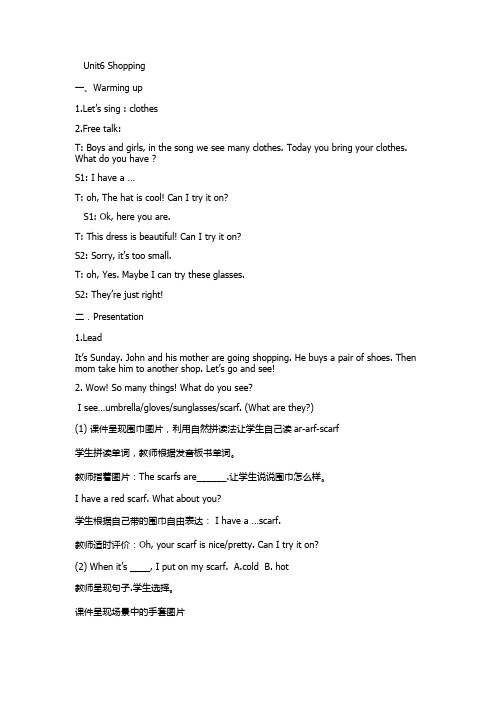
Unit6 Shopping一、Warming up1.Let’s sing : clothes2.Free talk:T: Boys and girls, in the song we see many clothes. Today you bring your clothes. What do you have ?S1: I have a …T: oh, The hat is cool! Can I try it on?S1: Ok, here you are.T: This dress is beautiful! Can I try it on?S2: Sorry, it’s too small.T: oh, Yes. Maybe I can try these glasses.S2: They’re just right!二.Presentation1.LeadIt’s Sunday. John and his mother are going shopping. He buys a pair of shoes. Then mom take him to another shop. Let’s go and see!2. Wow! So many things! What do you see?I see…umbrella/gloves/sunglasses/scarf. (What are they?)(1)课件呈现围巾图片,利用自然拼读法让学生自己读ar-arf-scarf学生拼读单词,教师根据发音板书单词。
教师指着图片:The scarfs are______.让学生说说围巾怎么样。
I have a red scarf. What about you?学生根据自己带的围巾自由表达: I have a …scarf.教师适时评价:Oh, your scarf is nice/pretty. Can I try it on?(2) When it’s ____, I put on my scarf. A.cold B. hot教师呈现句子.学生选择。
(完整word)pep四年级英语下册第六单元教案.doc
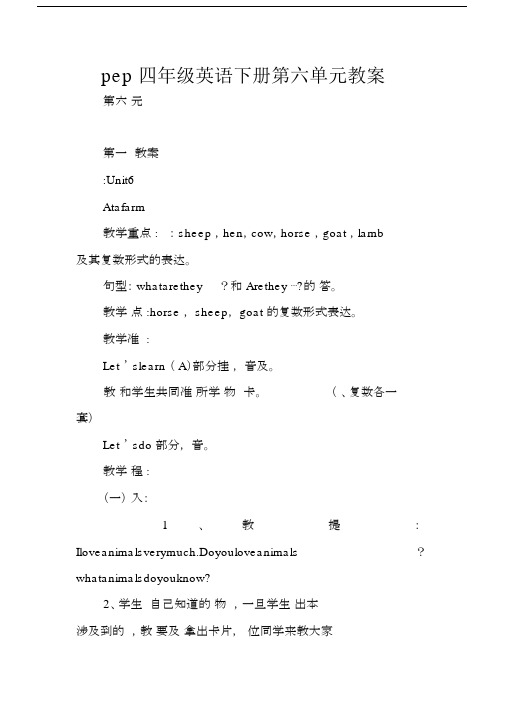
pep 四年级英语下册第六单元教案第六元第一教案:Unit6Atafarm教学重点 : : sheep ,hen,cow,horse ,goat ,lamb及其复数形式的表达。
句型: whatarethey?和Arethey⋯?的答。
教学点 :horse , sheep, goat 的复数形式表达。
教学准 :Let ’ slearn ( A)部分挂,音及。
教和学生共同准所学物卡。
(、复数各一套)Let ’ sdo 部分,音。
教学程 :(一)入:1、教提:Iloveanimalsverymuch.Doyouloveanimals?whatanimalsdoyouknow?2、学生自己知道的物,一旦学生出本涉及到的,教要及拿出卡片,位同学来教大家读。
(二)呈现新知:教师说:Doyouknowafarm?Therearemanyanimalsatafarm.Let’sgoandhavealook教师出示Let ’ slearn(A)部分挂图,说:Look,itisafarm.Somanyanimals.whatcanyousee?学生听懂后,教师可先试着让学生指图回答,能说出英文的学生给与表扬,也可让学生用中文回答。
告诉学生我们要学习有关farm 的内容,教读farm 。
让学生观看 2 遍,教师只点击有关单词部分,学生跟读。
教师出示单词卡: sheep ,hen,cow,horse ,goat ,lamb,让学生进行认读,教师可以将一些发音规律,帮助学生记忆单词。
如: ee 在 sheep 中发 [i : ]ow 在 cow 中发 [aU] ,oa 在 goat 中发 [EU] 等等,也可以启发学生说说怎样记住每个单词。
(将卡片贴到黑板上)巩固单词: a、教师说单词,学生指图。
b、教师指图,学生说单词。
c、一个学生说任意一个单词,其他学生举起相应的图片。
Let ’ sdo 部分:学生观看。
启学生根据所看内容feed ,ride ,milk ,shear ,hold 的意思。
PEP四年级下册英语教案Unit 6
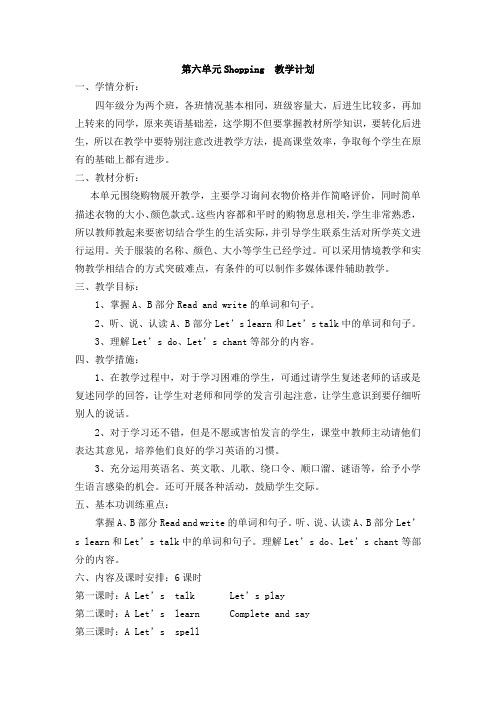
第六单元Shopping 教学计划一、学情分析:四年级分为两个班,各班情况基本相同,班级容量大,后进生比较多,再加上转来的同学,原来英语基础差,这学期不但要掌握教材所学知识,要转化后进生,所以在教学中要特别注意改进教学方法,提高课堂效率,争取每个学生在原有的基础上都有进步。
二、教材分析:本单元围绕购物展开教学,主要学习询问衣物价格并作简略评价,同时简单描述衣物的大小、颜色款式。
这些内容都和平时的购物息息相关,学生非常熟悉,所以教师教起来要密切结合学生的生活实际,并引导学生联系生活对所学英文进行运用。
关于服装的名称、颜色、大小等学生已经学过。
可以采用情境教学和实物教学相结合的方式突破难点,有条件的可以制作多媒体课件辅助教学。
三、教学目标:1、掌握A、B部分Read and write的单词和句子。
2、听、说、认读A、B部分Let’s learn和Let’s talk中的单词和句子。
3、理解Let’s do、Let’s chant等部分的内容。
四、教学措施:1、在教学过程中,对于学习困难的学生,可通过请学生复述老师的话或是复述同学的回答,让学生对老师和同学的发言引起注意,让学生意识到要仔细听别人的说话。
2、对于学习还不错,但是不愿或害怕发言的学生,课堂中教师主动请他们表达其意见,培养他们良好的学习英语的习惯。
3、充分运用英语名、英文歌、儿歌、绕口令、顺口溜、谜语等,给予小学生语言感染的机会。
还可开展各种活动,鼓励学生交际。
五、基本功训练重点:掌握A、B部分Read and write的单词和句子。
听、说、认读A、B部分Let’s learn和Let’s talk中的单词和句子。
理解Let’s do、Let’s chant等部分的内容。
六、内容及课时安排:6课时第一课时:A Let’s talk Let’s play第二课时:A Let’s learn Complete and say第三课时:A Let’s spell第四课时:B Let’s talk B Let’s act第五课时:B Let’s learn Let’s play第六课时:B Read and write , Let’s check , Let’s singUnit 6 Shopping 第一课时教学内容:A Let’s talk ; Let’s play教材分析:对话课学情分析:Let’s talk部分展现了John和妈妈一起去鞋垫买鞋的场景,引出本单元的教学话题。
PEP版小学英语四年级下册第六单元教案
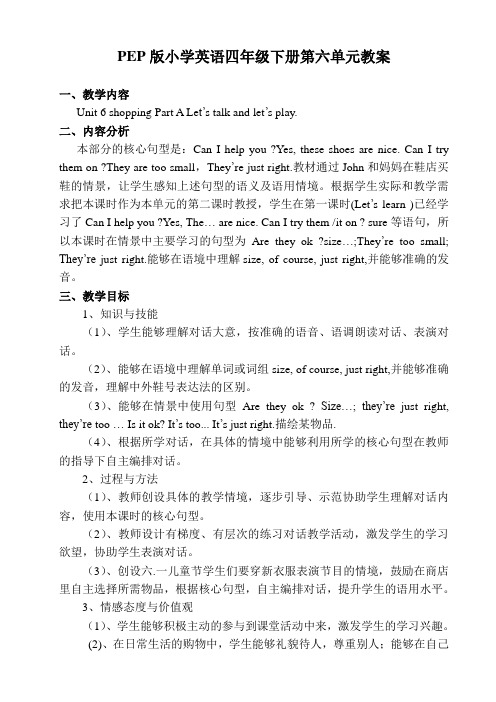
PEP版小学英语四年级下册第六单元教案一、教学内容Unit 6 shopping Part A Le t’s talk and let’s play.二、内容分析本部分的核心句型是:Can I help you ?Yes, these shoes are nice. Can I try them on ?They are too small,They’re just right.教材通过John和妈妈在鞋店买鞋的情景,让学生感知上述句型的语义及语用情境。
根据学生实际和教学需求把本课时作为本单元的第二课时教授,学生在第一课时(Let’s learn )已经学习了Can I help you ?Yes, The… are nice. Can I try them /it on ? sure等语句,所以本课时在情景中主要学习的句型为Are they ok ?size…;They’re too small; They’re just right.能够在语境中理解size, of course, just right,并能够准确的发音。
三、教学目标1、知识与技能(1)、学生能够理解对话大意,按准确的语音、语调朗读对话、表演对话。
(2)、能够在语境中理解单词或词组size, of course, just right,并能够准确的发音,理解中外鞋号表达法的区别。
(3)、能够在情景中使用句型Are they ok ? Size…; they’re just right, they’re too … Is it ok? It’s too... It’s just right.描绘某物品.(4)、根据所学对话,在具体的情境中能够利用所学的核心句型在教师的指导下自主编排对话。
2、过程与方法(1)、教师创设具体的教学情境,逐步引导、示范协助学生理解对话内容,使用本课时的核心句型。
(2)、教师设计有梯度、有层次的练习对话教学活动,激发学生的学习欲望,协助学生表演对话。
【PEP】四年级下英语Unit 6优质精品课教案

【PEP】四年级下英语Unit 6优质精品课教案一. 教材分析本单元的主题是关于日常活动,通过描述人们在不同时间所做的事情,让学生学会用英语表达自己的日常活动。
教材内容包括词汇学习、句型练习和对话交流,旨在提高学生的听说能力和语言运用能力。
二. 学情分析四年级的学生已经掌握了基本的英语语音、词汇和语法知识,具备一定的听说读写能力。
但是,学生在语言运用方面还存在一定的困难,需要通过大量的练习来提高。
此外,学生对新鲜事物充满好奇,善于模仿和参与活动,但注意力容易分散,需要教师通过有趣的教学手段来吸引他们的注意力。
三. 教学目标1.知识目标:学生能够掌握本课的词汇和句型,并能用英语描述自己的日常活动。
2.能力目标:学生能够听懂、会说、会读、会写本课的内容,提高语言运用能力。
3.情感目标:学生能够积极参与课堂活动,提高学习英语的兴趣。
四. 教学重难点1.重点:学生能够掌握本课的词汇和句型,并能用英语描述自己的日常活动。
2.难点:学生能够正确运用所学的词汇和句型,进行流畅的对话交流。
五. 教学方法1.情境教学法:通过设定生活情境,让学生在实际语境中学习英语,提高学生的语言运用能力。
2.任务型教学法:通过完成各种任务,激发学生的学习兴趣,培养学生的合作意识和解决问题的能力。
3.游戏教学法:通过设计有趣的游戏,让学生在轻松愉快的氛围中学习英语,提高学生的学习积极性。
六. 教学准备1.准备本课的PPT,包括单词、句型和对话的内容。
2.准备一些日常活动的图片,用于引导学生进行观察和描述。
3.准备一些小礼品,用于激励学生的学习积极性。
七. 教学过程1.导入(5分钟)教师通过播放一首关于日常活动的英文歌曲,吸引学生的注意力,然后引导学生一起唱这首歌,激发学生的学习兴趣。
2.呈现(10分钟)教师通过PPT展示本课的词汇和句型,并用生动的语言和动作进行解释,让学生初步感知和理解。
3.操练(10分钟)教师学生进行分组活动,让学生用所学的词汇和句型进行对话交流,教师巡回指导,纠正学生的错误。
PEP四年级下册第六单元教案和教学反思
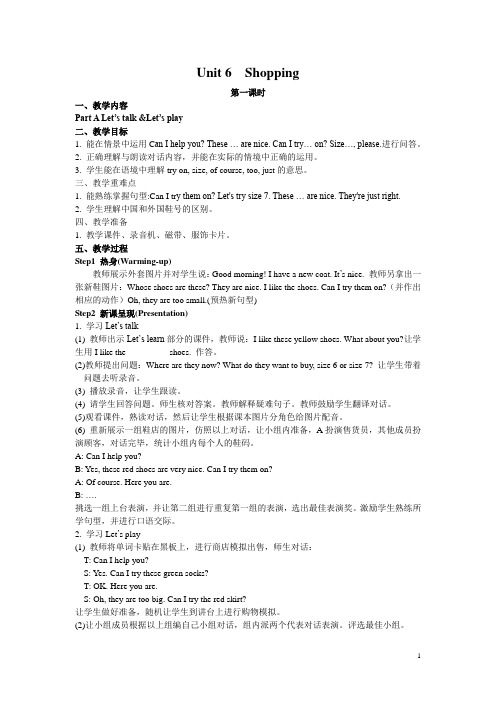
Unit 6 Shopping第一课时一、教学内容Part A Let’s talk &Let’s play二、教学目标1. 能在情景中运用C an I help you? These … are nice.Can I try… on? Size…, please.进行问答。
2. 正确理解与朗读对话内容,并能在实际的情境中正确的运用。
3. 学生能在语境中理解try on, size, of course, too, just的意思。
三、教学重难点1. 能熟练掌握句型:Can I tr y them on? Let's try size 7. These … are nice. They're just right.2. 学生理解中国和外国鞋号的区别。
四、教学准备1. 教学课件、录音机、磁带、服饰卡片。
五、教学过程Step1 热身(Warming-up)教师展示外套图片并对学生说:Good morning! I have a new coat. It’s nice. 教师另拿出一张新鞋图片:Whose shoes are these? They are nice. I like the shoes. Can I try them on?(并作出相应的动作)Oh, they are too small.(预热新句型)Step2 新课呈现(Presentation)1. 学习Let’s talk(1) 教师出示Let’s learn部分的课件,教师说:I like these yellow shoes. What about you?让学生用I like the _________ shoes. 作答。
(2)教师提出问题:Where are they now? What do they want to buy, size 6 or size 7? 让学生带着问题去听录音。
(3) 播放录音,让学生跟读。
Pep小学四年级英语下册Unit6_教案
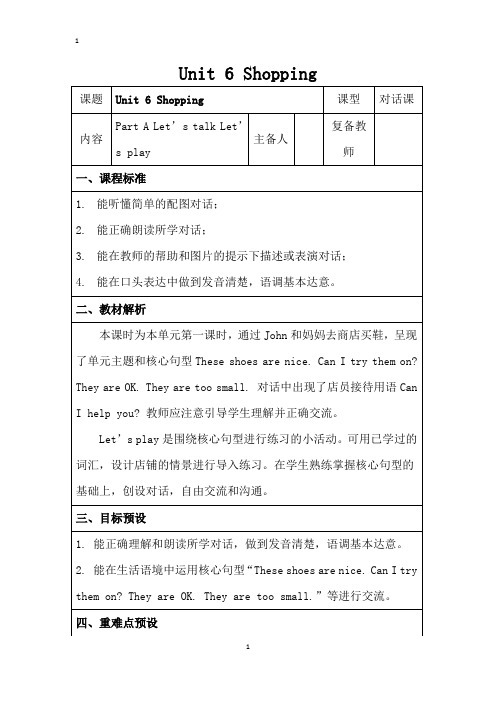
第3课时
教学环节
教学预设
热身/复习(Warm-up的词汇,用blending的方式,复习字母组合和词汇的发音,巩固发音规律。
2.导入:听唱歌谣,体会英语歌谣的韵律和语调。
Read the chant and try to find out the rules of these sounds. Two little birds are sitting on a wall.
呈现新课(Presentation)
1. Let’s spell
出示Read aloud的单词,小组互相读一读,听一听,想想包含了哪些发音规律。
2.听录音,跟读单词。
3.学生尝试读Try this部分的单词。
出示本部分单词图片,学生看图,说单词。
趣味操练
(Practice)
1. I can chant
教师可边听边下去了解学生在四线格中的书写情况,及时给予纠正。
4.打开U6 A Let’s spell课堂基础练/拔高练,即学即练,检测当堂学习情况。
小结
(Summary)
1.朗读歌谣。
2.朗读词汇,小组总结、巩固发音规则,给予评价。
作业设计
1.登录“优教同步学习网”,听录音,跟读所学单词和歌谣。
2.熟练朗读歌谣和故事,上传班级微信群。
2.没有展示的小组,继续练习歌谣,下节课表演。
3.登录“优教同步学习网”,预习Unit6 A Let’s spell。
七、板书设计:Unit 6 Shopping
Part A Let’s learn
scarf sunglasses gloves umbrella
—Can I help you?
—The gloves are nice.
《PEP四年级英语下册第六单元教案详解与实例演练》

PEP四年级英语下册第六单元教案详解与实例演练引言:英语作为国际通用语言,越来越受到人们的重视和关注,特别是在教育领域。
随着教育理念的不断更新和技术手段的不断提高,英语教学也发生了很大的变化。
在这样的背景下,我们也应该注重英语教学的实际效果,优化教学内容和方法,提高教学效率和质量。
本文以PEP四年级英语下册第六单元为例,详解教案和实例演练。
一、教学目标1.词汇:dress, sports shoes, woolly hat, coat, scarf, shorts2.句:What are you wearing? I'm wearing a dress/sports shoes/woolly hat/coat/scarf/shorts.3.能力目标:能听懂、会说并正确运用基本服装词汇,能正确使用句型What are you wearing? I'm wearing....,表达自己正在穿什么衣服。
二、教学重点和难点1.教学重点:掌握基本的服装词汇,理解并正确运用What are you wearing? I'm wearing....句型。
2.教学难点:区分不同的服装词汇,正确使用句型。
三、教学方法和过程1. 热身:复习前几个单元的知识,如问候语、数字、颜色、形状等,并设计简单的活动加强学生的英语语感。
2. 学习新知:教师通过图片、实物、PPT等多种形式展示和讲解基本的服装词汇,如dress, sports shoes, woolly hat, coat, scarf, shorts等,并让学生逐一模仿、朗读。
3. 实践运用:通过问答、小组活动、角色扮演等形式让学生逐渐掌握正确的句型What are you wearing? I'm wearing....并能在实际的情境中灵活运用。
4. 总结提高:总结本节课的重点和难点,同时巩固学生的知识和技能,如练习句型的口语表达和书写。
小学英语四年级下册第六单元精品教案
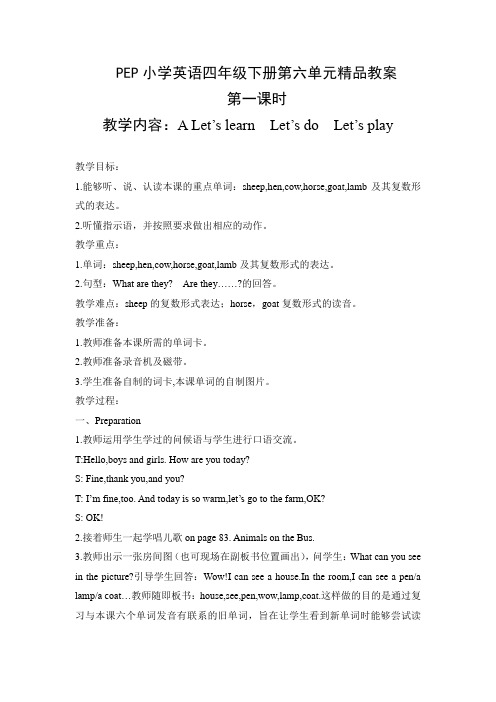
PEP小学英语四年级下册第六单元精品教案第一课时教学内容:A Let’s learn Let’s do Let’s play教学目标:1.能够听、说、认读本课的重点单词:sheep,hen,cow,horse,goat,lamb及其复数形式的表达。
2.听懂指示语,并按照要求做出相应的动作。
教学重点:1.单词:sheep,hen,cow,horse,goat,lamb及其复数形式的表达。
2.句型:What are they? Are they……?的回答。
教学难点:sheep的复数形式表达;horse,goat复数形式的读音。
教学准备:1.教师准备本课所需的单词卡。
2.教师准备录音机及磁带。
3.学生准备自制的词卡,本课单词的自制图片。
教学过程:一、Preparation1.教师运用学生学过的问候语与学生进行口语交流。
T:Hello,boys and girls. How are you today?S: Fine,thank you,and you?T: I’m fine,too. And today is so warm,let’s go to the farm,OK?S: OK!2.接着师生一起学唱儿歌on page 83. Animals on the Bus.3.教师出示一张房间图(也可现场在副板书位置画出),问学生:What can you see in the picture?引导学生回答:Wow!I can see a house.In the room,I can see a pen/a lamp/a coat…教师随即板书:house,see,pen,wow,lamp,coat.这样做的目的是通过复习与本课六个单词发音有联系的旧单词,旨在让学生看到新单词时能够尝试读出。
二、Presentation(一)单词导呈1.学习hen。
Look,what’s this? (画简笔画或出示图画)板书hen, 引导学生尝试去读:hen,然后教师适当领读。
人教PEP版-英语-四年级下册-2014最新版pep四下英语教案第六单元
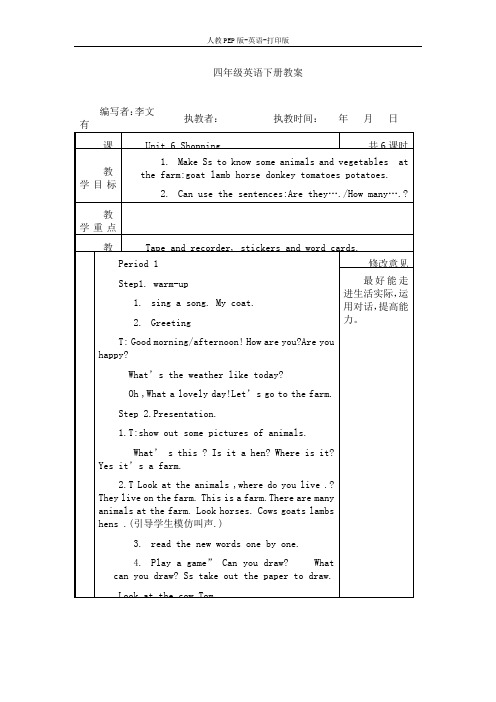
Step 1.warm-up
1.review some animals and big small long short
2.Let’s chant
Step 2. Presentation.
Read and write
1.Listen to the tape carefully. And answer the questions
2.T: What can you see in the picture?
3.Play a game.
a.Show me /Touch your ……..
b.Guess : I have a tomato ..,where are they?
c.How many tomatoes can you see ?
2.read and act in pairs.
3.统计出所带的蔬菜。
Name
tomato
potato
cucumber
0nion
carrot
4.Let’s watch TV. And answer the quertions/
5.read after the tape .
6.do the Let’s check/
(4)T:.act out the animals in the farm to have a meeting.
(5)Learn the song. animals
(6)Good to know .:教给学生一些关于动物的英语谚语和小故事.
(7)Work :
Do some exercise in the workbook.
4.read it .(tomato tomatoes)注意复数
2014年新版pep四年级英语下册Unit-6-Shopping教案设计
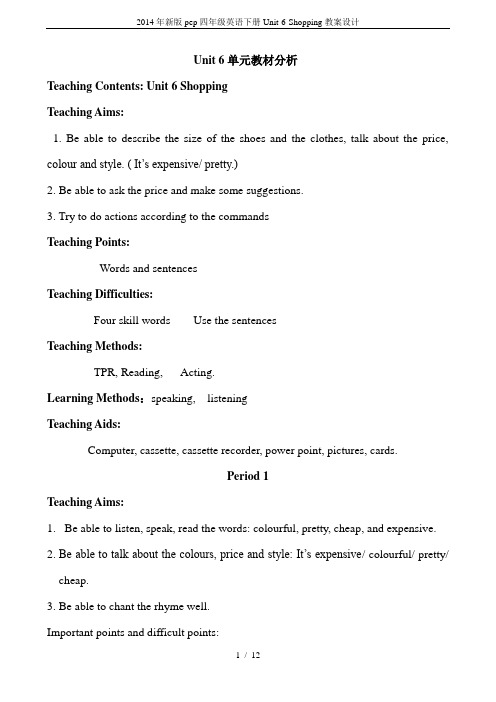
Unit 6单元教材分析Teaching Contents: Unit 6 ShoppingTeaching Aims:1. Be able to describe the size of the shoes and the clothes, talk about the price, colour and style. ( It’s expensive/ pretty.)2. Be able to ask the price and make some suggestions.3. Try to do actions according to the commandsTeaching Points:Words and sentencesTeaching Difficulties:Four skill words Use the sentencesTeaching Methods:TPR, Reading, Acting.Learning Methods:speaking, listeningTeaching Aids:Computer, cassette, cassette recorder, power point, pictures, cards.Period 1Teaching Aims:1. Be able to listen, speak, read the words: colourful, pretty, cheap, and expensive.2. Be able to talk about the colours, price and style: It’s expensive/ colourful/ pretty/ cheap.3. Be able to chant the rhyme well.Important points and difficult points:New words and sentencesTeaching methods: listening, speakingLearning Methods:speaking, listeningTeaching Aids:Computer, cassette, cassette recorder, power point, pictures, cards.Teaching Steps:1. Warm –up.a. Free talkAsk some questions like the following:T: What’s the weather like today?Ss: It’s cloudy and warm.T: Can you wear your sweater?Ss: No, I can’t.b. Let’s chant. Mmm, It’s warm t oday.2. Preview.Let’s chant: My shirt is red. My jacket is blue…. Try to present the new words in a natural way.3. Presentation.Let’s learn.(1) Draw different clothes with nice colors on the blackboard. Ask:What’s this? It’s a dress/ jacket/skirt.Look at this skirt. What colour is it? Is it pretty? /colourful? How much is? Is it expensive/cheap/big/long/small/short?Help the Ss to answer them.Present the new words with the help of the real objects.(2) Show them the flash cards, to listen and repeat the new words: colourful, pretty, cheap, and expensive.(3) Play a game.a. I say cheap, Ss say expensive, or on the opposite.b. Cheap or expensive?Tell Ss that more than 80 is expensive, less than 79 is cheap. Put the price on the bag, pen, pencil, b ooks, clothes, Ss see the price, then say It’s cheap/expensive. To see who can see the fastest.(4) Listen and repeat.Let Ss listen to tape recorder, repeat aloud.Then help Ss to say these following sentences: Look at that … It’s… I want to buy it. It’s…yuan.(5) Extension.Use the real objects to show Ss a dialogue like this:A: Can I help you?B: Yes, I ‘d like a pen.A: Look at that pen. Is it nice?B; Yes, it’s pretty. I like itHow much is it?A: It’s 2 yuan.B: Oh, it’s cheap. I want buy i t.A: Here you are.Get Ss to make more dialogues using the words and expressions.(5) Listen and chant in groups.4. Homework.a. Copy the key words.b. Listen and chant together.Board-writing:Unit 6 Shoppingpretty cheap expensive.It’s … It’s. …Yuan. I want to buy it.Period 2Teaching Aims:3. Be able to listen, speak, read the new words well: sixty seventy ninety-nine hundred assistant help how much that’s= that is4. Be able to talk about the colours, price and style: That’s expensive/ colourful / pretty /cheap. How much is it? It’s …yuan.5. . Be able to use the language skillfully.Important points and difficult points:1. Listen, speak, read the key words well.2. Be able to communicate with the useful language points:Can I help you? How much is this dress/ shirt/jacket?Difficulty words: expensive pretty colourful ninety-nineTeaching methods: listening, speakingLearning Methods:speaking, listeningTeaching Aids:Computer, cassette, cassette recorder, power point, pictures, cards. Teaching Steps:5. Warm –up.a. Sing a song. My clothes.b. Listen and chant with the tape.c. Listen and do. (For Unit 5)6. Preview.Play the tape for Ss to listen to the song of Unit 5: The Coat in the Window.7. Presentation.Let’s talk(1) Make a dialogue with an individual student.T: Hello, How much is your shirt?S. It’s thirty yuan.T: Is it expensive?S: No, but it’s pretty.(2) Look, listen and imitate.a. Look at the picture. Ask some questions. Who can you see? What does Amy want to buy? How much is it? Is it cheap?b. Watch VCD tape. Try to understand the dialogue.c. Listen to the dialogue, repeat with the tape.d. Play a game; Higher or lower?Student holds a pen up: The others try to guess the price.S1: How much is this pen?S2: It’s two yuan.S1: Higher! Higher!S3: It’s Four yuan.S1: Lower! Lower!S4: It’s three yuan.S1: Yes.(3) Group talk.Try to ask the price of their own clothes or the stationeries. Then make a survey.(4) Practice the dialogue in the real situation.(5) Act out their dialogues.8. Homework.a. Read the dialogue aloud.b. Finish the exercise in activity book.Board-writing:Unit 6 ShoppingAssistant: Can I help you? Ninety-nineCustomer: Yes, I want … sixty seventyThat’s expensive/ cheap. It’s too …Period 3Teaching Aims:1.Be able to listen, speak, read the dialogue well.2.Be able to talk about the size, price and style of the things you want to buy.3. Group work: To make a survey. Ask the prices of your frien ds’ clothes. Important points and difficult points:1.Listen, speak, read the key words well.2.Be able to communicate with the useful expressions.3. Try to make a dialogue about the shopping by themselves.4. Difficult sentences: How about this pair? Are they all right? Yes, they are. / No, they aren’t. We’ll take them.Teaching methods: listening, speakingLearning Methods:speaking, listeningTeaching Aids:Computer, cassette, cassette recorder, power point, pictures, cards.Teaching Steps:9. Warm –up.a. Let’s do. (Listen and do actions)b. Greetings and everyday English.10. Preview.Play the tape for Ss to listen to the song of Unit 5: The Coat in the Window.11. Presentation.Let’s talk(1) Make a dialogue with an individual student.T: Hello, Are you wearing a pair of sandals?S. No, I’m wearing a pair of sneakers.T: Look at my sandals. They are old. I want to buy a new pair.Let’s go shopping together.S: Good idea.(2) Look, listen and imitate.a. Look at the picture. Ask some questions.b. Watch VCD tape. Try to understand the dialogue.c. Explain the difficulties: What size? Size 5. Are they all right? We’ll take them.d. Listen to the dialogue, repeat with the tape.e. Group talk. Make a survey.To know the size. Ask; What size do you wear? I wear size 37. How much are your sandals/ sneakers/ slippers?f. Practice the dialogue in groups.g. Act out the dialogue.h. Play a game.Guess the size of what they wear.What size do you wear? Guess.Size 5.Smaller. Size 4.i. If time permits, let Ss go to buy the things they have in groups.12. Homework.a. Read the dialogue aloud.b. Finish the exercise in activity book.Board-writing:Unit 5 How much is it?A pair of sneakers for my son.What size?How about this pair? How much are they?We’ll take them.Period 4Teaching Aims:1.Be able to listen, speak, read and write the key words well: apple, pear, orange, banana, and watermelon.2.Be able to say and write the main sentences: How much are they?They’re three Y uan.3.. Be able to use the language skillfully.Important points and difficult points:New words and sentencesTeaching methods: listening, speakingLearning Methods:speaking, listeningTeaching Aids:Computer, cassette, cassette recorder, power point, pictures, cards.Teaching Steps:13. Warm –up.a. Let’s do.b. Greetings and daily report.14. Preview.a. Make a survey: Ask Ss to think of what size of shoes and clothes their family members wear. Ask them some questions.3. Presentation.a. Show Ss the chart let them look at it carefully. Ask them questions.What does Zoom want to buy?What fruits do you know?Does Zoom want any lemons?How many apples does Zoom want?b. Ask the Ss to say something about the picture.c. Show them the cards, help Ss say: one apple, five apples, ten pears, ten oranges, and two big watermelons.d. Play a game: Show them pictures, let Ss quickly say the plural forms of the words:two apples, three bananas…e. Listen and watch the dialogue.a) Read and practice the dialogue.g. Act out the dialogue with headdresses.h. Let Ss make their own dialogue in groups.i. Do the exercises on the activity book.15. Homework.a. Read the dialogue aloud.b. Finish the exercise in activity book.c. Copy the key sentences and words one line each. Board-writing:Unit 6 ShoppingA fruit shop apples pearsPictures oranges bananasWatermelonsHow much are they? They’re three Yuan.。
新人教PEP版小学四年级英语下册 Unit 6 Period 1 Part A 优质教案
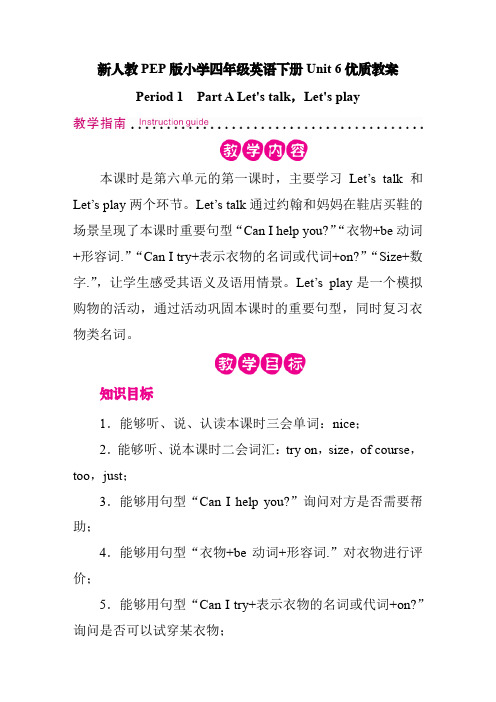
新人教PEP版小学四年级英语下册Unit 6优质教案Period 1Part A Let's talk,Let's play本课时是第六单元的第一课时,主要学习Let’s talk和Let’s play两个环节。
Let’s talk通过约翰和妈妈在鞋店买鞋的场景呈现了本课时重要句型“Can I help you?”“衣物+be动词+形容词.”“Can I try+表示衣物的名词或代词+on?”“Size+数字.”,让学生感受其语义及语用情景。
Let’s play是一个模拟购物的活动,通过活动巩固本课时的重要句型,同时复习衣物类名词。
知识目标1.能够听、说、认读本课时三会单词:nice;2.能够听、说本课时二会词汇:try on,size,of course,too,just;3.能够用句型“Can I help you?”询问对方是否需要帮助;4.能够用句型“衣物+be动词+形容词.”对衣物进行评价;5.能够用句型“Can I try+表示衣物的名词或代词+on?”询问是否可以试穿某衣物;6.能够用句型“Size+数字.”描述物品的尺码;7.能够理解Let’s talk的对话内容并分角色表演对话。
能力目标培养学生的口语表达能力和交际能力。
情感目标鼓励学生大胆发言,勇于用英语表达。
教学重点1.能够用句型“Can I help you?”询问对方是否需要帮助;2.能够用句型“衣物+be动词+形容词.”对衣物进行评价;3.能够用句型“Can I try+表示衣物的名词或代词+on?”询问是否可以试穿某衣物;4.能够用句型“Size+数字.”描述物品的尺码。
教师让学生在语境中理解句子的含义并讲解句型,然后通过小组合作、活动等方式反复操练句型,以突破重点。
教学难点能够在实际情景中灵活运用本课时句型进行购物。
教师先和一名学生示范购物,然后让学生模仿范例进行对话练习,最后通过模拟购物的活动让学生能够灵活运用所学句型。
- 1、下载文档前请自行甄别文档内容的完整性,平台不提供额外的编辑、内容补充、找答案等附加服务。
- 2、"仅部分预览"的文档,不可在线预览部分如存在完整性等问题,可反馈申请退款(可完整预览的文档不适用该条件!)。
- 3、如文档侵犯您的权益,请联系客服反馈,我们会尽快为您处理(人工客服工作时间:9:00-18:30)。
Unit6 Shopping参考教案第六单元教学计划一、单元教学内容分析1、单元教学内容:本单元围绕购物展开教学,主要学习询问衣物价格并作简略评价,同时简单描述衣物的大小、颜色款式。
这些内容都和平时的购物息息相关,学生非常熟悉,所以教师教起来要密切结合学生的生活实际,并引导学生联系生活对所学英文进行运用。
关于服装的名称、颜色、大小等学生已经学过。
这一单元主要谈论服装的价格和评价。
可以和第三单元描述天气及第五单元谈论衣服两个话题很好的结合起来,教师在教学中可以从学生已学过的知识入手,在复习的过程中引入本单元的新知识,使学生能把学过的语言结合起来进行运用。
在教学Can I help you?等购物交际句型时,教师可创设交际情境,在交际活动中融入新的句型,使交际更贴近生活,更真实。
教师应当设计多种交际活动,让孩子在交际的过程中,真正掌握语言。
2、单元三、教学重点:学习有关衣服和鞋子的大小、评论价格、颜色和款式。
3、单元四、教学难点::A、B部分的Let’s talk和B部分的Let’s learn。
可以采用情境教学和实物教学相结合的方式突破难点,有条件的可以制作多媒体课件辅助教学。
二、单元一、教学目标:1、掌握A、B部分Read and write的单词和句子。
2、听、说、认读A、B部分Let’s learn和Let’s talk中的单词和句子。
3、理解Let’s do、Let’s chant等部分的内容。
三、单元教学准备:1、教师准备教学过程中所需要的图片、声音、课件,以及本单元的单词卡。
2、准备一些教师的照片或图片。
3、教师准备录音机及录音带。
四、单元教学措施:1、在教学过程中,对于学习困难的学生,可通过请学生复述老师的话或是复述同学的回答,让学生对老师和同学的发言引起注意,让学生意识到要仔细听别人的说话。
2、对于学习还不错,但是不愿或害怕发言的学生,课堂中教师主动请他们表达其意见,培养他们良好的学习英语的习惯。
3、充分运用英语名、英文歌、儿歌、绕口令、顺口溜、谜语等,给予小学生语言感染的机会。
还可开展各种活动,鼓励学生交际。
五、单元教学反思:第一课时(实施日期:年月日)一、教学目标:1、能够听、说、认读本课时的主要句型:Can I try them on. Let's try size 7.They're just right.2、能够跟录音朗读对话并进行表演。
二、教具准备:教学光盘、单词卡片。
三、教学重点:学习新句型:Can I try them on. Let's try size 7.They're just right.四、教学难点:在情景交际中正确使用本课时的新句型。
五、教学过程:复习引题1、日常口语训练。
教学新课1、教师出示Let’s learn部分的挂图,让孩子表演图中的情景,教师与学生共同表演对话。
教师挑出两双鞋,一双适合自己的脚,另一双或大或小,然后让学生猜哪一双是自己的鞋,引出新句型的教学。
2、教师指导学生做问答练习,然后调查同伴的鞋的号码,进行小组汇报。
3、待学生能够熟悉句型后,教师为学生放VCD,让学生感知对话内容。
4、学生跟录音朗读课文,教师指导学生朗读。
学生分角色朗读对话。
巩固练习1、教师播放一段购物的视频录像,孩子观看录像后用自己学过的句子和单词进行描述。
2、小组交流自己看到的内容。
布置作业1、听第58页的Let’s talk 部分的录音,读给同伴、朋友或家长听。
五、板书设计Can I try them on. Let's try size 7.They're just right.六、教学反思第二课时(实施日期:年月日)一、教学目标:1、学习四个名词sunglasses, gloves, umbrella, scarf。
2、在A部分对话的基础上,运用本课时及A部分学过内容进行实际的交际活动。
二、教具准备:教学光盘、单词卡片。
三、教学重点:本课时的四个单词。
四、教学难点:在实际情境中运用词汇。
五、教学过程:复习引题1、Let’s talk:学生读一读,并进行角色表演。
3、Guessing game:教师将各种标有价钱的衣服放到一个大储物袋中,让学生猜一猜里面有什么,学生猜对后,取出并描述一下大小、价钱等。
教学新课1、教师出示大挂图,让孩子结合图说一说What can you see? 引出新单词。
2、通过引入情景表演,描述图中的各种物品。
3、学生进行情景表演练习,并熟悉新的单词。
4、出示课件,让孩子观看课件(关掉声音),根据故事的内容给课件配音5、播放课件,孩子看课件理解含义。
6、孩子分角色跟读。
巩固练习1、做Complete and say的练习,先以两人一组完成表格填空,然后全班展示。
3 / 82、做作业本上配套的练习。
布置作业1、读课文第59页;2、用英语向家长介绍自己的衣物。
板书设计sunglasses, gloves, umbrella, scarf六、教学反思第三课时(实施日期:年月日)一、教学目标:1、复习本册的所有字母组合的发音。
2、能听、说、读、写本册的四会单词。
二、教具准备:教学光盘、单词卡片。
三、教学重点:能听、说、读、写本册的四会单词。
四、教学难点:正确书写本册的四会单词。
五、教学过程:复习引题1、师生做日常口语练习:A: Can I help you?B: Yes...A: Are they OK?B: ...2、请学生表演A部分Let’s talk的对话。
教学新课1、播放Read aloud的录音,让学生听歌谣。
2、让学生跟着动画学说歌谣,同时可用手打节奏。
3、播放Listen and chant的录音,让学生划出含有字母组合的单词。
巩固练习1、完成作业本上的配套练习。
布置作业1、抄本册四会单词4+1模式。
板书设计computer dinner girl wall homework nursecard little people world六、教学反思第四课时(实施日期:年月日)一、教学目标:1、听懂会说:“Can I help yo u? How much is this skirt? It's very pretty. That's expensive. It's too expensive.”2、能在实际的情景中运用进行实际交际。
3、培养孩子购物要节约的观念。
二、教具准备:教学光盘、单词卡片。
三、教学重点:句型:Can I help you? How much is this skirt? It's very pretty. That's expensive. It's too expensive.四、教学难点:对新词的读音的指导和规范,如:“eighty-nine yuan.”五、教学过程:复习引题1、日常口语训练。
2、用算术题复习数字,为价格的描述作好准备。
教学新课1、教师通过课件展示各种衣物。
2、教师和孩子们进行对话的交流T: Look at this shirt .It’s colourful.S: Yes, it’s pretty.T: How much is it?S (请一个孩子走到背面翻出价格)It’s one hundred yuan . It’s too expensive.3、教师播放课件,让孩子观看故事,理解内容。
5 / 84、再看一边,边看边模仿故事中人物的语气说一说。
5、分角色给课件配音,小组练习和表演。
巩固练习1、孩子运用自己手中的卡片,仿照Let’s talk部分中的对话,进行对话和描述,完成Let act。
布置作业1、听第61页的Let’s talk 部分的录音,读给同伴、朋友或家长听板书设计Can I help you? How much is this skirt?It's very pretty. That's expensive. It's too expensive.六、教学反思第五课时(实施日期:年月日)一、教学目标:1、能够听说认读本课主要单词:nice,pretty, cheap , expensive。
2、能运用句子:It's cheap/pretty/expensive/nice.来描述价格和颜色。
二、教具准备:教学光盘、单词卡片。
三、教学重点:单词:nice,pretty, cheap , expensive。
句子:It's cheap/pretty/expensive/nice.四、教学难点:单词expensive的读音;根据实际情景运用本课时的四个形容词。
五、教学过程:复习引题1、Talk about the weatherWhat’s the weather like today?What do you want to wear?2、Show us your clothes孩子们走到台前,介绍一下自己的衣服的颜色,样子。
教学新课1、教师出示几件衣服的实物,并标出价格,说:“Guess, how much is it?”引导学生回答价格,教师追问:“Is it cheap?/Is it pretty?” 引导学生自己表述:“It’s cheap/expensive/ nice /pretty.”教师根据学生的回答适时的出示相应的单词cheap/expensive/ nice /pretty.并进行带读,让孩子进行认读练习。
2、教师出示Let’s learn部分的挂图。
T: “Look at that dress. It’s pretty. I want to buy it.It’s …yuan.”Students try to say like this.3、观看课件展示,跟读练习。
4、小组活动:孩子两人一组。
每个孩子准备一些衣物单词的小卡片,在背面写出价格,两人进行购物的对话练习。
教师先和一个孩子进行示范(T: How much is that nice dress? S:Very expensive. It’s …yuan.T:I want to buy it.)巩固练习1、Guessing game:How much is it? 孩子两人一组,运用一些衣物小卡片,猜测价格。
A: Guess, How much is it?B: It’s twenty yuan .A: No , too cheap. Guess again.B: …2、完成Let's play的练习。
布置作业板书设计单词:nice,pretty, cheap , expensive。
句子:It's cheap/pretty/expensive/nice.六、教学反思第六课时(实施日期:年月日)一、教学目标:1、能让学生运用They are... 写句子。
